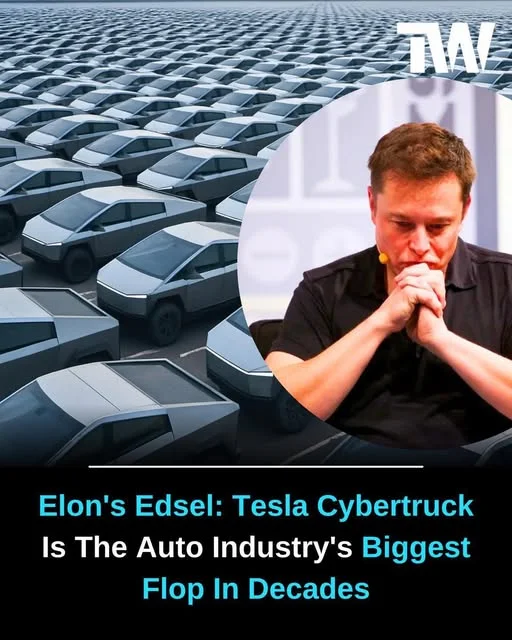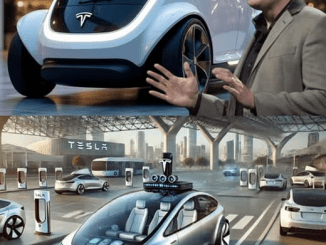
Elon Musk’s much-anticipated Tesla Cybertruck has had a rollercoaster journey since it was first unveiled in late 2019. Marketed as a revolutionary vehicle that would redefine the future of trucks, the Cybertruck has generated significant hype — but after years of delays, missteps, and growing skepticism, some critics have begun to label it the auto industry’s biggest flop in decades. Is this the “Edsel” moment for Tesla? Let’s take a deeper look.
1. The Edsel Comparison
The Ford Edsel, introduced in 1957, is often considered one of the biggest failures in automotive history. Despite heavy anticipation and marketing, it was plagued by design issues, poor timing, and consumer confusion. Ford ultimately discontinued the Edsel just three years later, and it became a symbol of overhyped products that didn’t meet consumer expectations.
Fast forward to the Cybertruck — which some critics argue is Tesla’s modern-day Edsel. The comparisons stem from a few key factors:
- Misalignment with Consumer Expectations: Much like the Edsel, the Cybertruck has been marketed as a groundbreaking vehicle, but many consumers are struggling to understand its appeal. The design, which is unlike anything else on the market, has drawn mixed reactions. While some applaud its boldness, others find its angular, almost absurdly futuristic look off-putting, leading to concerns that Tesla has created a vehicle that doesn’t align with what truck buyers actually want.
- Execution Issues: The Cybertruck’s rollout has been a textbook example of overpromising and underdelivering. Tesla initially promised to have the Cybertruck in production by late 2021, but multiple delays have pushed that timeline further into the future. The company also had to deal with issues like the broken window debacle during the truck’s unveiling, which showcased the Cybertruck’s supposed “unbreakable” windows shattering on stage.
2. Overhyped Design and Styling
One of the primary criticisms of the Cybertruck is its unconventional and polarizing design. Tesla enthusiasts have been quick to defend the Cybertruck’s “unique” aesthetic, but the general public has been less enthusiastic.
- Styling Concerns: The sharp, polygonal look of the Cybertruck is far removed from traditional truck designs, and while some see it as a bold move into the future, others see it as a design that simply doesn’t fit the bill for most truck buyers. For many, the Cybertruck’s look is more akin to a sci-fi prop than a practical, everyday vehicle.
- Market Resistance: Traditional pickup truck buyers in the U.S. have a deep affinity for the tried-and-true designs of the Ford F-150, Ram 1500, and Chevrolet Silverado. The Cybertruck’s jarring design raises questions about whether it can truly resonate with this market, which prioritizes rugged utility over avant-garde styling.
3. Price Tag and Market Viability
At launch, Tesla promised that the Cybertruck would start at around $39,900 for the base model — an aggressive price point for an electric pickup truck. However, recent reports suggest that the price could end up being significantly higher, especially with inflation and rising production costs. This could make the Cybertruck a less appealing choice for consumers who are already price-sensitive, especially in the wake of higher inflation and the global cost-of-living crisis.
- Cost vs. Value: Tesla has also promised impressive specifications, including long-range capabilities, high towing capacity, and off-road performance. However, whether these features will justify the truck’s price is still uncertain. As more details about the vehicle’s final specs and price emerge, some potential buyers may balk at paying a premium for what many see as a “gimmick” truck with an untested track record in real-world performance.
4. Production Delays and Logistical Hurdles
Tesla has made a name for itself as a high-tech company that can disrupt industries, but its history of ambitious promises and delayed timelines is well-documented. The Cybertruck is no different.
- Delayed Launches: After being first announced in 2019, Tesla originally projected a production timeline that had the Cybertruck hitting roads in late 2021. However, after multiple delays, it is expected that the truck will not begin mass production until late 2023 or early 2024 — and that’s assuming everything goes according to plan. These delays are frustrating potential buyers who are eager to make the leap into an electric pickup.
- Supply Chain Woes: In addition to delays in production, Tesla has had to contend with supply chain disruptions, including the semiconductor shortage that has affected the global automotive industry. These challenges could further delay Cybertruck deliveries and exacerbate the company’s logistical woes.
5. The Market Has Changed
The landscape for electric vehicles (EVs) has shifted dramatically since the Cybertruck was first unveiled. At the time, Tesla’s Cybertruck was seen as a leader in the EV truck space, but now the competition is heating up:
- Rivian’s R1T: Rivian’s all-electric R1T, released in 2021, has garnered positive reviews for its performance, design, and build quality. With a more conventional truck design and a focus on premium features, it has been well-received by truck enthusiasts.
- Ford F-150 Lightning: Ford’s electric version of the best-selling F-150 pickup has also hit the market, offering a more familiar and trusted name to consumers looking for an electric alternative. With a traditional look and practical features, the F-150 Lightning is proving that the electric truck market can be both functional and accessible.
- Chevrolet Silverado EV: General Motors’ electric Silverado is another formidable contender, promising to offer the rugged capabilities expected from a pickup with all the benefits of an electric powertrain.
In this more competitive landscape, Tesla’s ability to stand out with the Cybertruck becomes even more difficult. The truck’s over-the-top promises, combined with a polarizing design and production delays, make it harder for Tesla to maintain its early advantage.
6. Tesla’s Future: Still Hope for the Cybertruck?
Despite the criticism, it’s important to recognize that the Cybertruck still holds potential, especially for Tesla fans and those drawn to the idea of a futuristic, electric truck. Tesla has proven time and time again that it can innovate and lead in the electric vehicle market, and the Cybertruck might eventually become a cult favorite, much like the DeLorean in the 1980s.
However, whether the Cybertruck will ever meet the lofty expectations set by its introduction is another question. If it fails to resonate with the truck-buying public, it could be remembered not as a revolution in the automotive industry, but as the Edsel of the electric age.
Conclusion: The Cybertruck’s Risky Road Ahead
While it may be premature to declare the Tesla Cybertruck a flop at this point, the vehicle is certainly facing significant hurdles. Whether it can overcome design flaws, production delays, and increasing competition remains to be seen. One thing is clear: if the Cybertruck doesn’t find its footing, it could go down in history as one of the most high-profile product missteps in recent automotive history.
For now, all eyes are on Tesla to see if the Cybertruck can live up to the promises — or if it will be relegated to the realm of automotive “what could have been.”


